Longitudinal Compressive Property of Three-Dimensional Four-Step Braided Composites after Cyclic Hygrothermal Aging under High Strain Rates
Abstract
1. Introduction
2. Experimentation
2.1. Material and Specimens
2.2. Hygrothermal Cycling
2.3. Microscopy Observation
2.4. SHPB Tests
2.5. Experimental Procedure for SHPB
3. Results and Discussion
3.1. Moisture Absorption Behavior
3.2. Typical Dynamic Compressive Process for Braided Composites Captured by High-Speed Camera
3.3. Dynamic Mechanical Properties for Braided Composites with Different Hygrothermal Aging Days
3.4. Hygrothermal Aging Effects for Braided Composites under High Strain Rates
4. Conclusions
- (1)
- The saturated moisture absorption of 3D four-step braided composites was not reached over the full duration of 210 cyclic hygrothermal aging days, the maximum moisture absorption was 0.6944%, and the composites did not show very much non-linear moisture behavior, compared with the T700/TDE85 laminated composites in our previous work.
- (2)
- The damage evolution of 3D four-step composites during the whole cyclic hygrothermal aging days mainly included epoxy hydrolysis and interfaces debonding.
- (3)
- The dynamic compressive stress-strain curves for the 3D four-step braided composites both behaved in a similar way, whether cyclic hygrothermal aging or not, and a linear response in the initial stage had no significant yield before reaching the peak stress.
- (4)
- The peak stress of the 3D four-step braided composites still behaved as a strain rate effect after cyclic hygrothermal aging, however, the dynamic stiffness modulus clearly had no specific regularity.
- (5)
- The peak stress and the dynamic stiffness modulus of 3D four-step braided composites after 210 cyclic hygrothermal aging days almost decreased by half when subjected to longitudinal compression.
Author Contributions
Funding
Acknowledgments
Conflicts of Interest
References
- Schultheisz, C.R.; Waas, A.M. Compressive failure of composites, Part I: Testing and micromechanical theories. Prog. Aerosp. Sci. 1996, 32, 1–42. [Google Scholar] [CrossRef]
- Wang, H.; Hazell, P.J.; Shankar, K.; Morozov, E.V.; Escobedo, J.P. Impact behaviour of Dyneema® fabric-reinforced composites with different resin matrices. Polym. Test. 2017, 61, 17–26. [Google Scholar] [CrossRef]
- Li, Z.; Khennane, A.; Hazell, P.J.; Remennikov, A.M. Performance of a hybrid GFRP-concrete beam subject to low-velocity impacts. Compos. Struct. 2018, 206, 425–438. [Google Scholar] [CrossRef]
- Huang, H.J.; Waas, A.M. Modeling and predicting the compression strength limiting mechanisms in Z-pinned textile composites. Compos. Part B Eng. 2009, 40, 530–539. [Google Scholar] [CrossRef]
- Pankow, M.; Waas, A.M.; Yen, C.F.; Ghiorse, S. Shock loading of 3D woven composites: A validated finite element investigation. Compos. Struct. 2011, 93, 1347–1362. [Google Scholar] [CrossRef]
- Zhang, D.; Waas, A.M.; Yen, C.F. Progressive damage and failure response of hybrid 3D textile composites subjected to flexural loading, part I: Experimental studies. Int. J. Solids Struct. 2015, 75–76, 309–320. [Google Scholar] [CrossRef]
- Xuan, H.J.; Wu, R.R. Aeroengine turbine blade containment tests using high-speed rotor spin testing facility. Aerosp. Sci. Technol. 2006, 10, 501–508. [Google Scholar] [CrossRef]
- Guan, Y.P.; Zhao, Z.H.; Chen, W.; Gao, D.P. Foreign object damage to fan rotor blades of aeroengine part I: Experimental study of bird impact. Chin. J. Aeronaut. 2008, 21, 328–334. [Google Scholar]
- Gu, B.H.; Xu, J.Y. Finite element calculation of 4-step 3-dimensional braided composite under ballistic perforation. Compos. Part B Eng. 2004, 35, 291–297. [Google Scholar] [CrossRef]
- Sun, B.Z.; Liu, F.; Gu, B.H. Influence of the strain rate on the uniaxial tensile behavior of 4-step 3D braided composites. Compos. Part A Appl. Sci. Manuf. 2005, 36, 1485. [Google Scholar] [CrossRef]
- Sun, B.Z.; Gu, B.H. High strain rate behavior of 4-step 3D braided composites under compressive failure. J. Mater. Sci. 2007, 42, 2463–2470. [Google Scholar] [CrossRef]
- Sun, B.Z.; Gu, B.H. In-plane compressive behaviors of 3-D textile composites at various strain rates. Appl. Compos. Mater. 2007, 14, 193–207. [Google Scholar] [CrossRef]
- Walter, T.R.; Subhash, G.; Sankar, B.V.; Yen, C.F. Damage modes in 3D glass fiber epoxy woven composites under high rate of impact loading. Compos. Part B Eng. 2009, 40, 584–589. [Google Scholar] [CrossRef]
- Zhang, F.; Wan, Y.; Gu, B.H.; Sun, B.Z. Impact compressive behavior and failure modes of four-step three-dimensional braided composites-based meso-structure model. Int. J. Damage Mech. 2015, 24, 805–827. [Google Scholar] [CrossRef]
- Tan, H.C.; Huang, X.; Liu, L.L.; Guan, Y.P.; Chen, W. Dynamic compressive behavior of four-step three-dimensional braided composites along three directions. Int. J. Impact Eng. 2019, 134, 103366. [Google Scholar] [CrossRef]
- Diamant, Y.; Marom, G.; Broutman, L.J. The effect of network structure on moisture absorption of epoxy resins. J. Appl. Polym. Sci. 1981, 26, 3015–3025. [Google Scholar] [CrossRef]
- Davies, P.; Mazéas, F.; Casari, P. Sea water aging of glass reinforced composites: Shear behaviour and damage modelling. J. Compos. Mater. 2001, 35, 1343–1372. [Google Scholar] [CrossRef]
- Joliff, Y.; Rekik, W.; Belec, L.; Chailan, J.F. Study of the moisture/stress effects on glass fibre/epoxy composite and the impact of the interphase area. Compos. Struct. 2014, 108, 876–885. [Google Scholar] [CrossRef]
- Abdel, M.B.; Ziaee, S.; Gass, K.; Schneider, M. The combined effects of load, moisture and temperature on the properties of E-glass/epoxy composites. Compos. Struct. 2005, 71, 320–326. [Google Scholar] [CrossRef]
- Tsenoglou, C.J.; Pavlidou, S.; Papaspyrides, C.D. Evaluation of interfacial relaxation due to water absorption in fiber-polymer composites. Compos. Sci. Technol. 2006, 66, 2855–2864. [Google Scholar] [CrossRef]
- Ogi, K. Influence of thermal history on transverse cracking in a carbon fiber reinforced epoxy composite. Adv. Compos. Mater. 2003, 11, 265–275. [Google Scholar] [CrossRef]
- Zhang, A.; Lu, H.; Zhang, D. Effects of voids on residual tensile strength after impact of hygrothermal conditioned CFRP laminates. Compos. Struct. 2013, 95, 322–327. [Google Scholar] [CrossRef]
- Yilmaz, T.; Sinmazcelik, T. Effects of hydrothermal aging on glass-fiber/polyetherimide (PEI) composites. J. Mater. Sci. 2010, 45, 399–404. [Google Scholar] [CrossRef]
- Sun, P.; Zhao, Y.; Luo, Y.; Sun, L. Effect of temperature and cyclic hygrothermal aging on the interlaminar shear strength of carbon fiber/bismaleimide (BMI) composite. Mater. Des. 2011, 32, 4341–4347. [Google Scholar] [CrossRef]
- Li, G.; Pang, S.S.; Helms, J.E.; Ibekwe, S.I. Low velocity impact response of GFRP laminates subjected to cycling moistures. Polym. Compos. 2000, 21, 686–695. [Google Scholar] [CrossRef]
- Liotier, P.J.; Vautrin, A.; Beraud, J.M. Microcracking of composites reinforced by stitched multiaxials subjected to cyclical hygrothermal loadings. Compos. Part A Appl. Sci. Manuf. 2011, 42, 425–437. [Google Scholar] [CrossRef]
- Mikhaluk, D.S.; Truong, T.C.; Borovkov, A.I.; Lomov, S.V.; Verpoest, I. Experimental observations and finite element modelling of damage initiation and evolution in carbon/epoxy non-crimp fabric composites. Eng. Fract. Mech. 2008, 75, 2751–2766. [Google Scholar] [CrossRef]
- Patel, S.R.; Case, S.W. Durability of hygrothermally aged graphite/epoxy woven composite under combined hygrothermal conditions. Int. J. Fatigue 2002, 24, 1295–1301. [Google Scholar] [CrossRef]
- Liu, L.L.; Zhao, Z.Z.; Chen, W.; Shuang, C.; Luo, G. An experimental investigation on high velocity impact behavior of hygrothermal aged CFRP composites. Compos. Struct. 2018, 204, 645–657. [Google Scholar] [CrossRef]
- Zhang, M.; Zuo, C.; Sun, B.Z.; Gu, B.H. Thermal ageing degradation mechanisms on compressive behavior of 3-D braided composites in experimental and numerical study. Compos. Struct. 2016, 140, 180–191. [Google Scholar] [CrossRef]
- Song, L.; Li, J. Effects of heat accelerated aging on tensile strength of three dimensional braided/epoxy resin composites. Polym. Compos. 2012, 3, 1635–1643. [Google Scholar]
- ASTM Standard. ASTM D 5229–29M—Standard Test Method for Moisture Absorption Properties and Equilibrium Conditioning of Polymer Matrix Composite Materials; Annual Book of ASTM Standards; ASTM International: West Conshohocken, PA, USA, 2010. [Google Scholar] [CrossRef]
- De Sarmot, G.; Salvia, M.; Vautrin, A.; Colombaro, A.M. Influence of long term maintenance on the performances of composites for Super Sonic Transportation. In Proceedings of the First National Colloquium of Aeronautic Researches on the Supersonic Aircraft, Paris, France, 6–7 February 2002. [Google Scholar]
- Li, Y.; Chen, Y.; Sheng, G.; Li, G. Hygrothermal aging effects for aircraft composite structures. In Proceedings of the 11th National Conference on Composite Materials, Hefei, China, 21–25 October 2000. (In Chinese). [Google Scholar]
- Liu, L.L.; Zhao, Z.Z.; Chen, W.; Xue, M.F.; Shuang, C. Interlaminar shear property and high-velocity impact resistance of CFRP laminates after cyclic hygrothermal aging. Int. J. Crashworthiness 2019, 1–14. [Google Scholar] [CrossRef]
- Kolsky, H. An investigation of the mechanical properties of materials at very high rates of loading. Proc. Phys. Soc. Sect. B 1949, 62, 676–700. [Google Scholar]
- Gama, B.A.; Lopatnikov, S.L.; Gillespie, J.W. Hopkinson bar experimental technique: A critical review. Appl. Mech. Rev. 2004, 57, 223–250. [Google Scholar] [CrossRef]
- Kumosa, L.; Benedikt, B.; Armentrout, D.; Kumosa, M. Moisture absorption properties of unidirectional glass/polymer composites used in composite (non-ceramic) insulators. Compos. Part A Appl. Sci. Manuf. 2004, 35, 1049–1063. [Google Scholar] [CrossRef]
- Gautier, L.; Mortaigne, B.; Bellenger, V. Interface damage study of hydrothermally aged glass-fibre-reinforced polyester composites. Compos. Sci. Technol. 1999, 59, 2329–2337. [Google Scholar]
- Gagani, A.I.; Echtermeyer, A.T. Fluid diffusion in cracked composite laminates—Analytical, numerical and experimental study. Compos. Sci. Technol. 2018, 160, 86–96. [Google Scholar] [CrossRef]
- Morii, T.; Ikuta, N.; Kiyosumi, K.; Hamada, H. Weight-change analysis of the interphase in hygrothermally aged FRP: Consideration of debonding. Compos. Sci. Technol. 1997, 57, 985–990. [Google Scholar] [CrossRef]
- Zhou, J.; Lucas, J.P. Hygrothermal effects of epoxy resin. Part I: The nature of water in epoxy. Polymer 1999, 40, 5505–5512. [Google Scholar] [CrossRef]
- Tan, H.C.; Liu, L.L.; Guan, Y.P.; Chen, W.; Zhao, Z.Z. Investigation of three-dimensional braided composites subjected to steel projectile impact: Automatically modelling mesoscale finite element model. Compos. Struct. 2019, 209, 317–327. [Google Scholar]
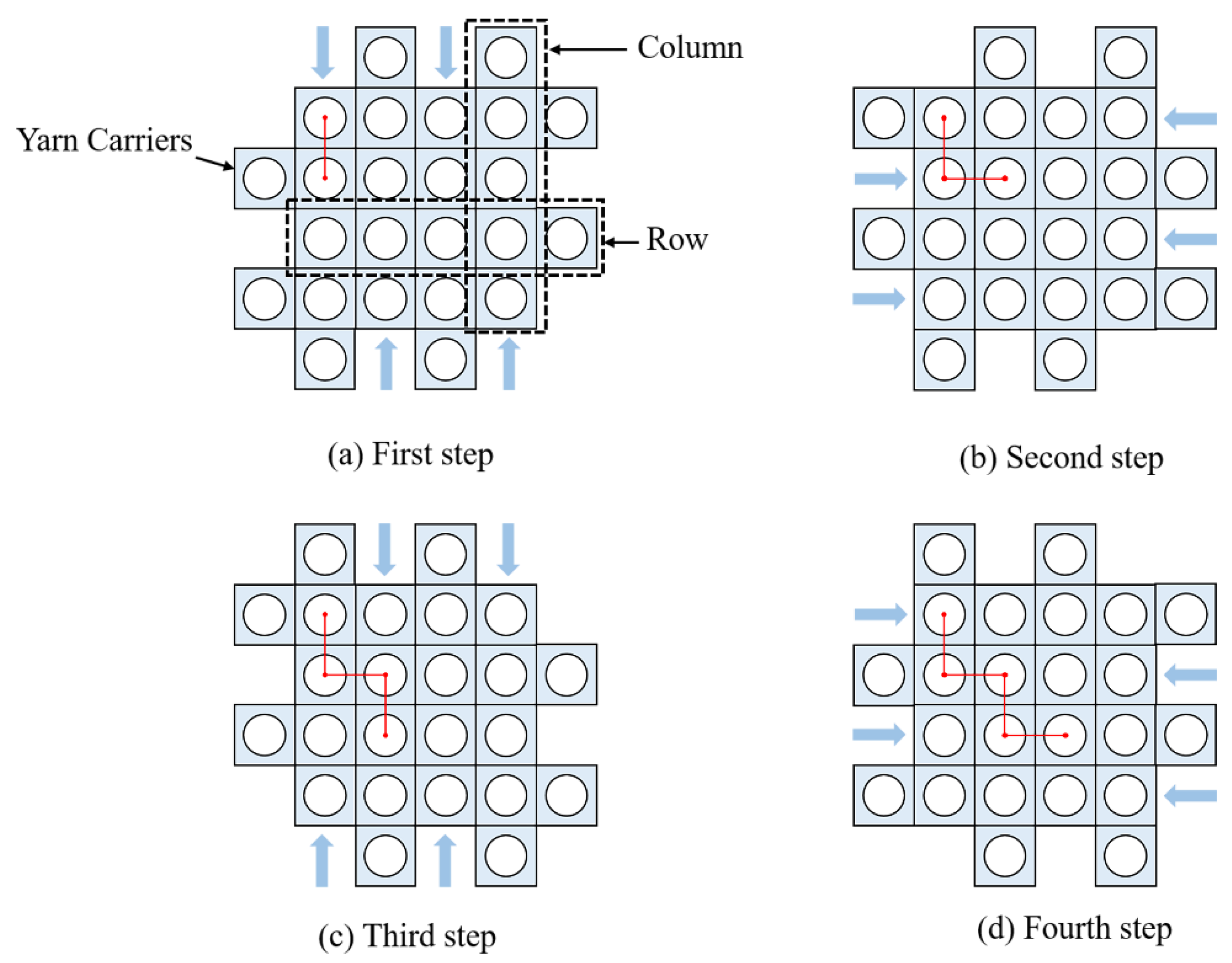
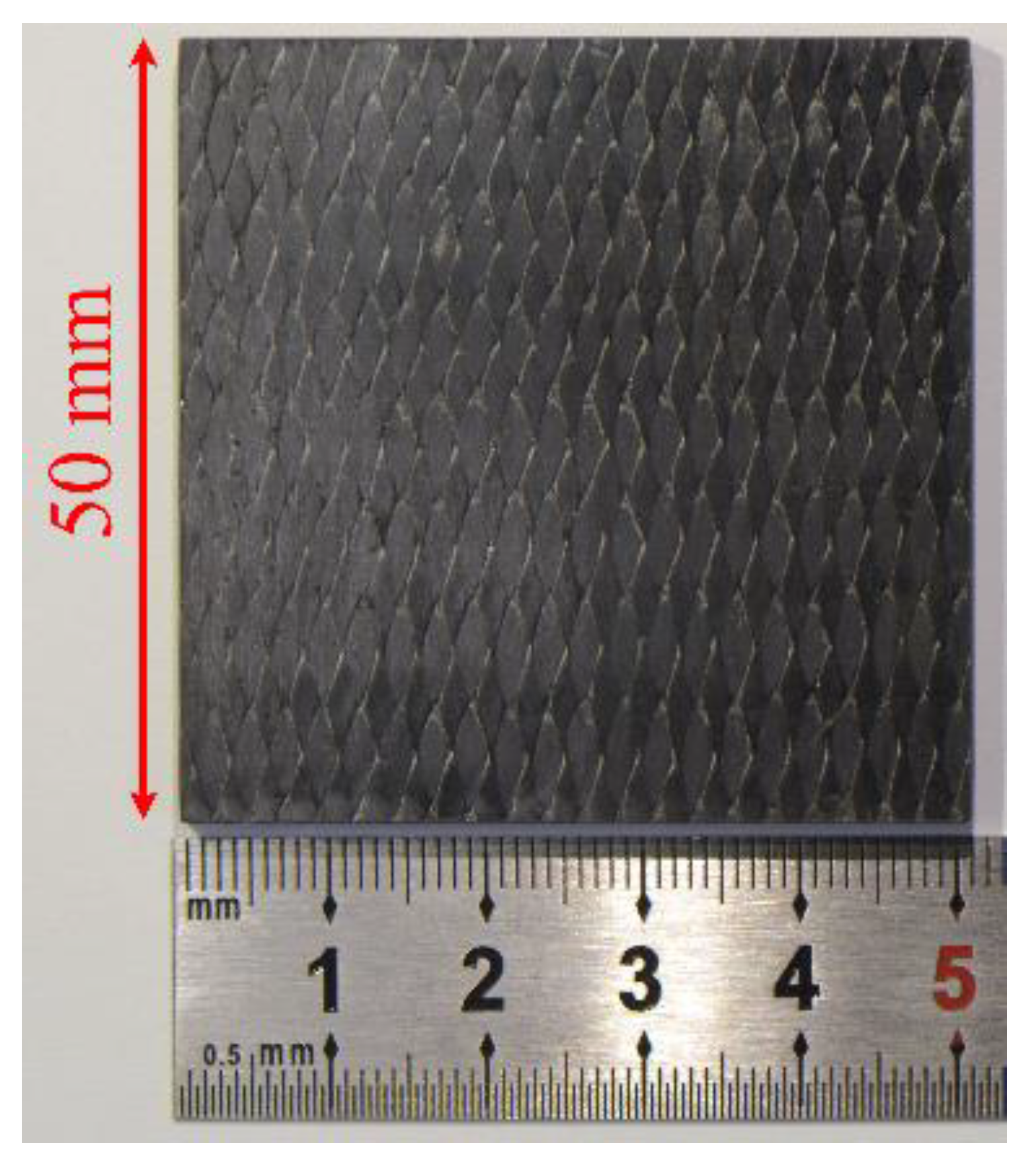
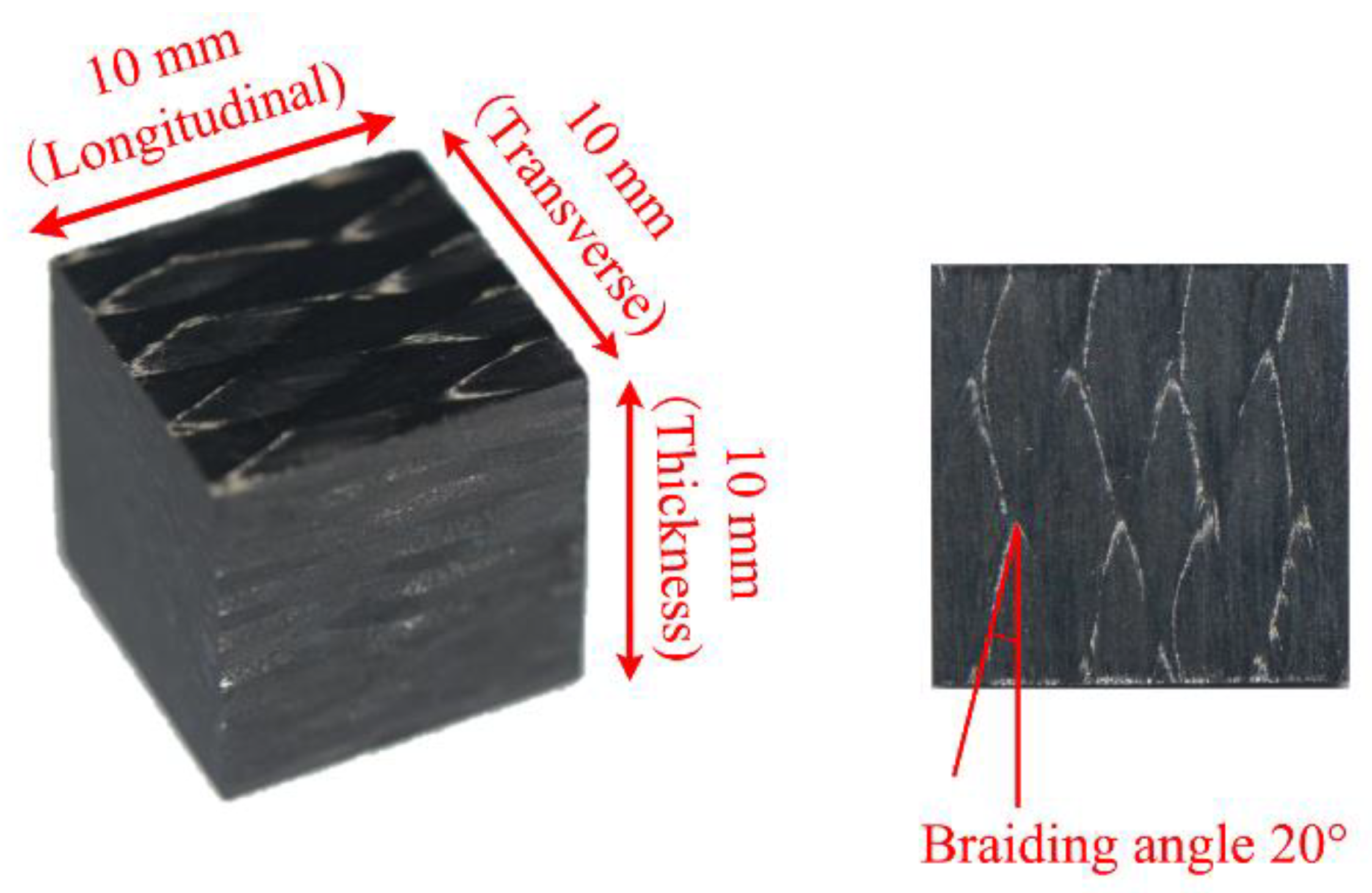


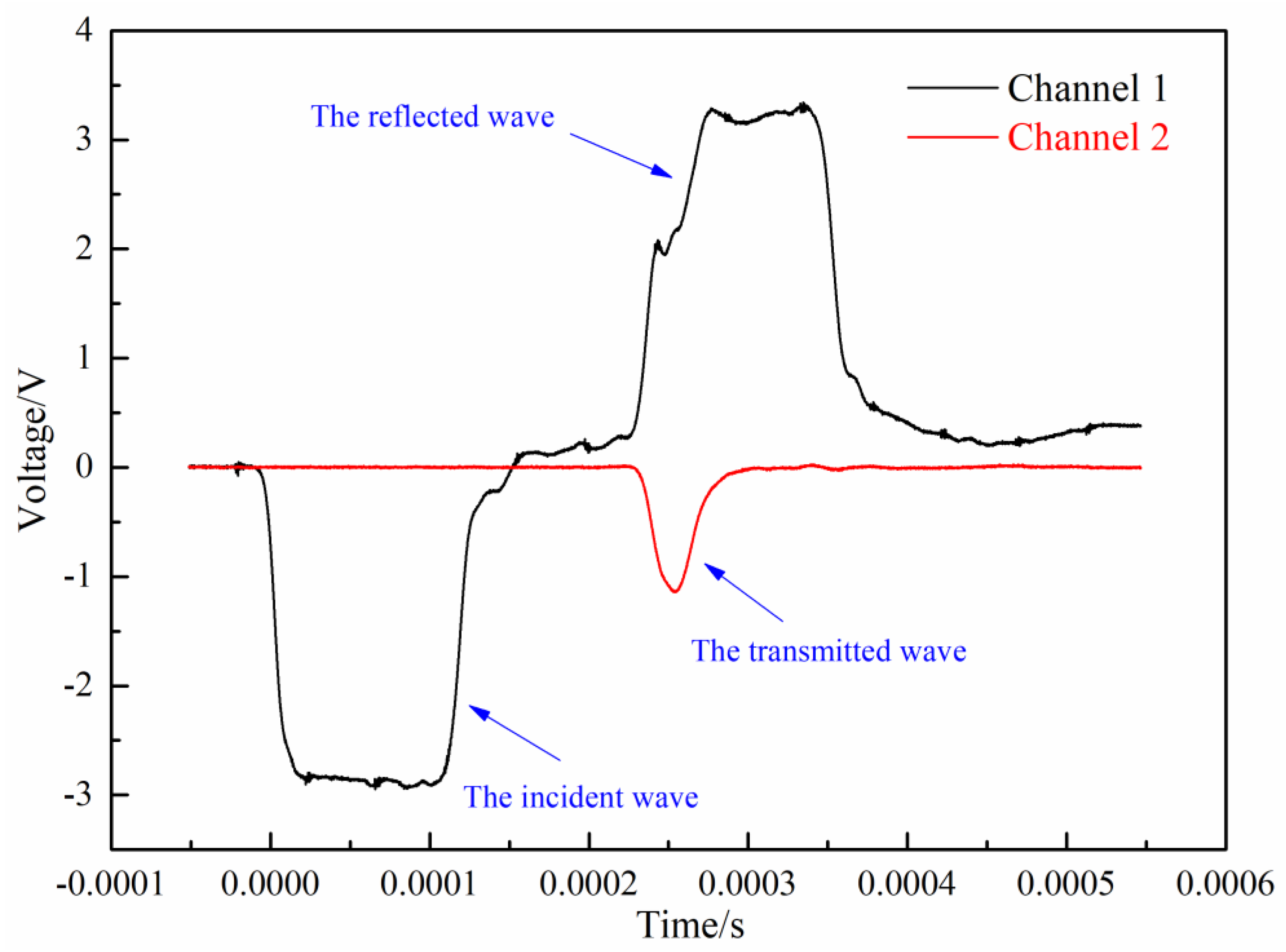
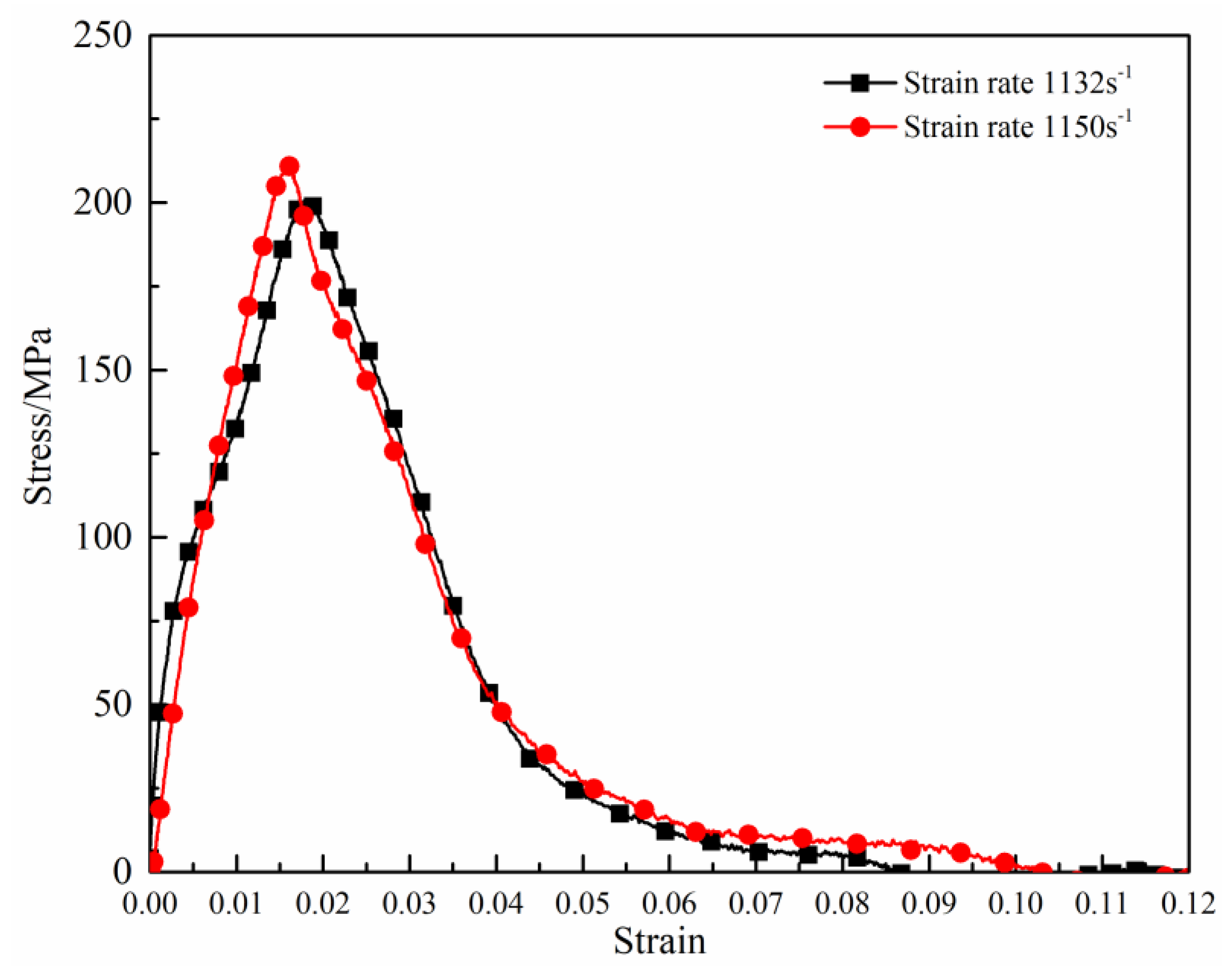
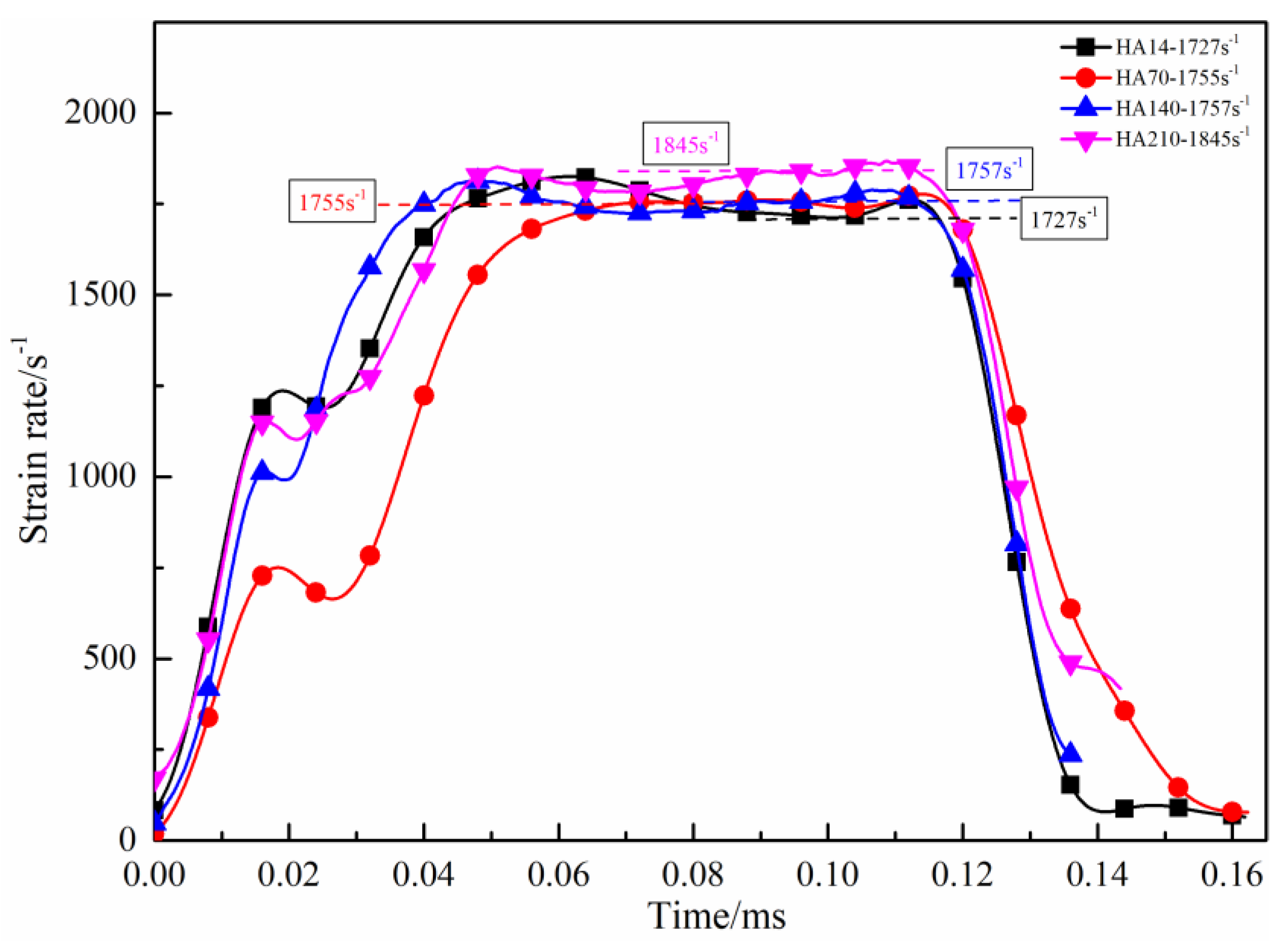
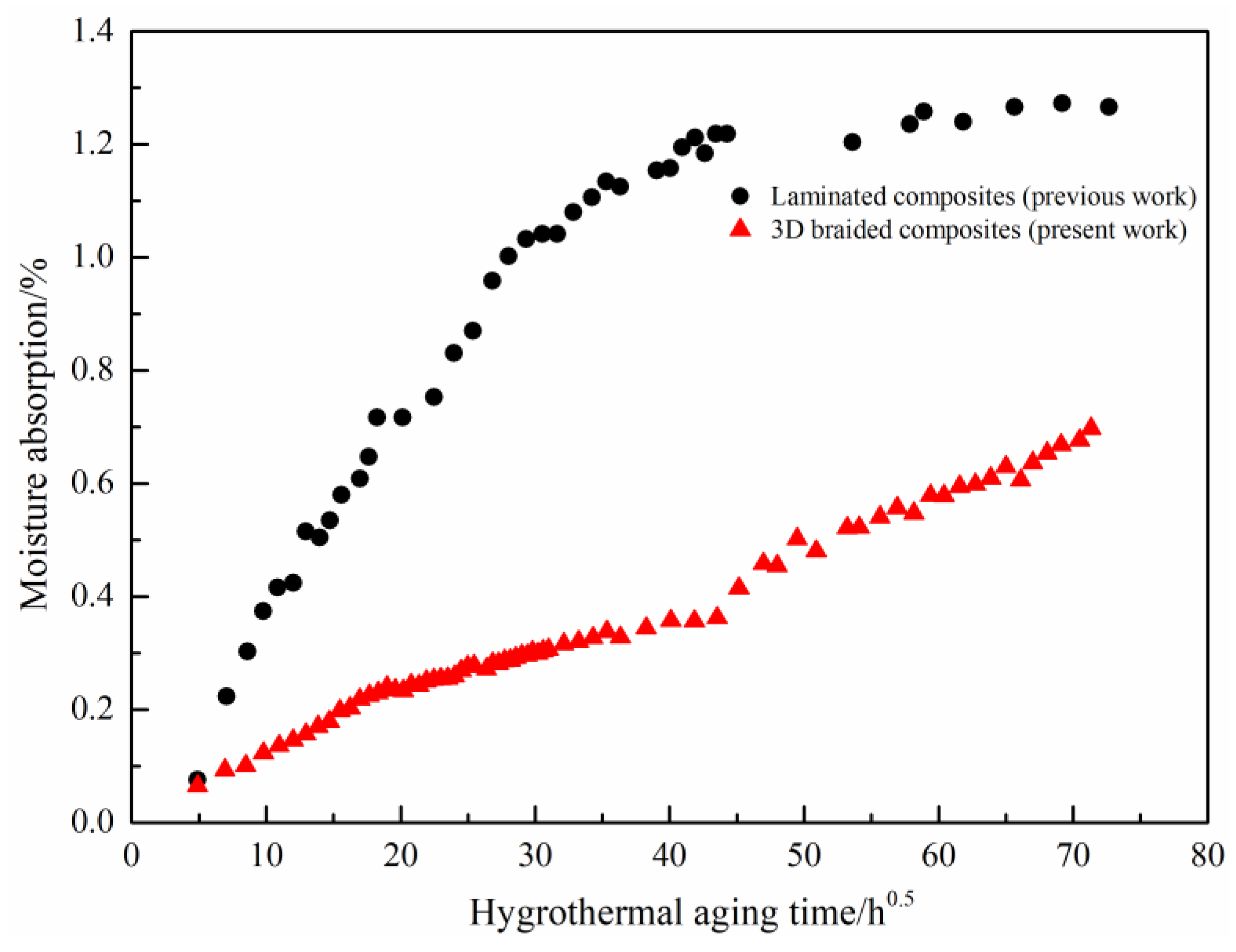
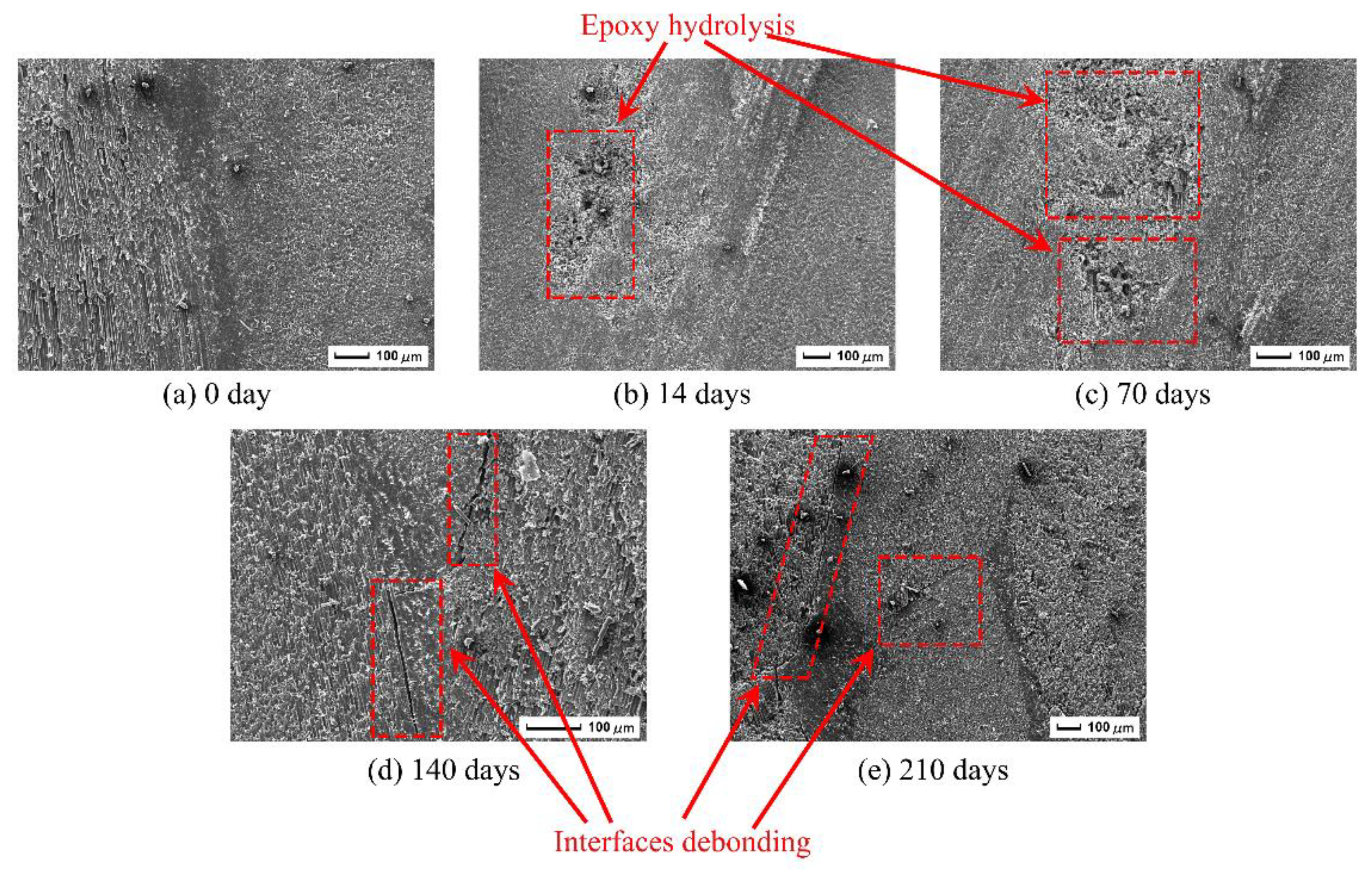



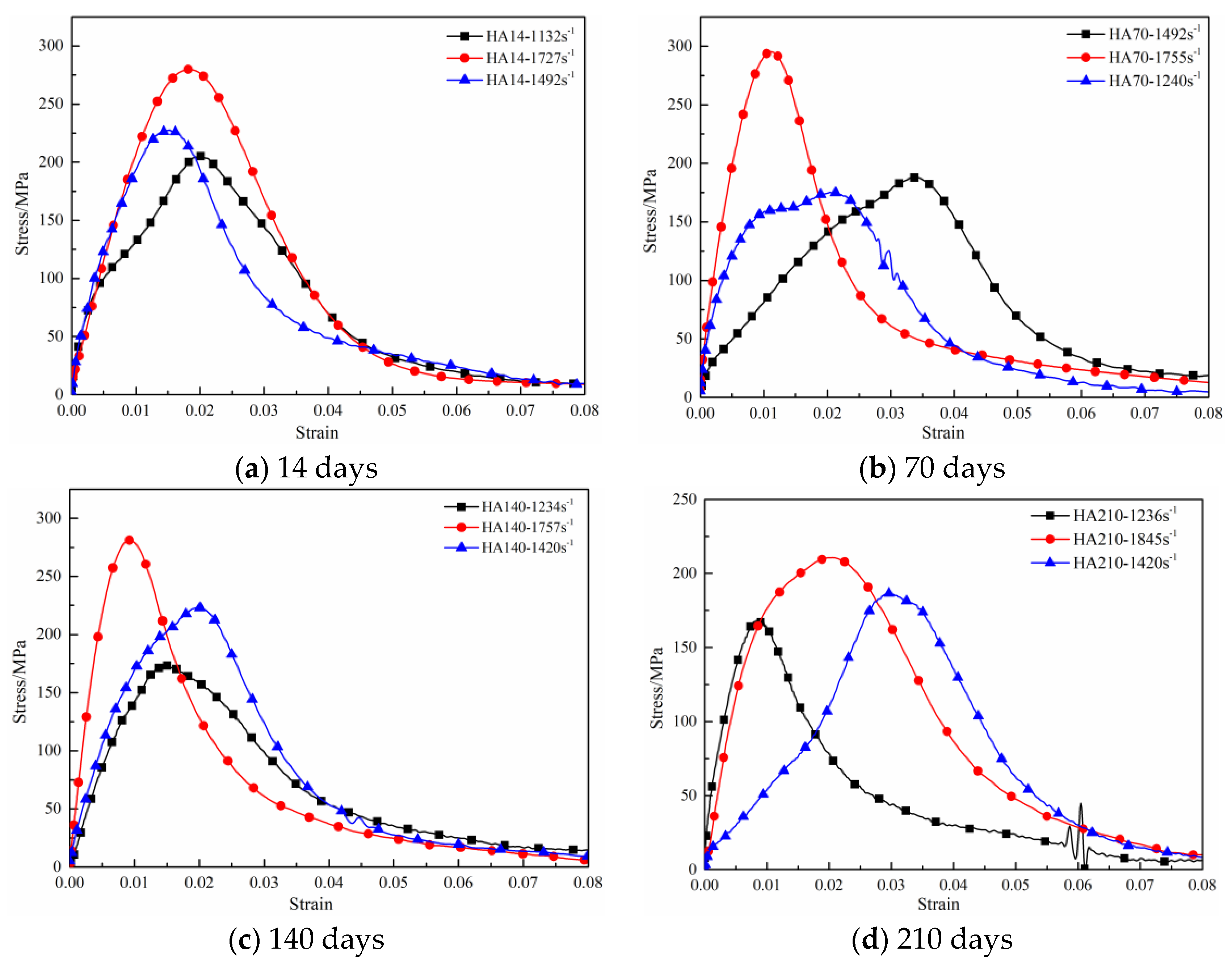
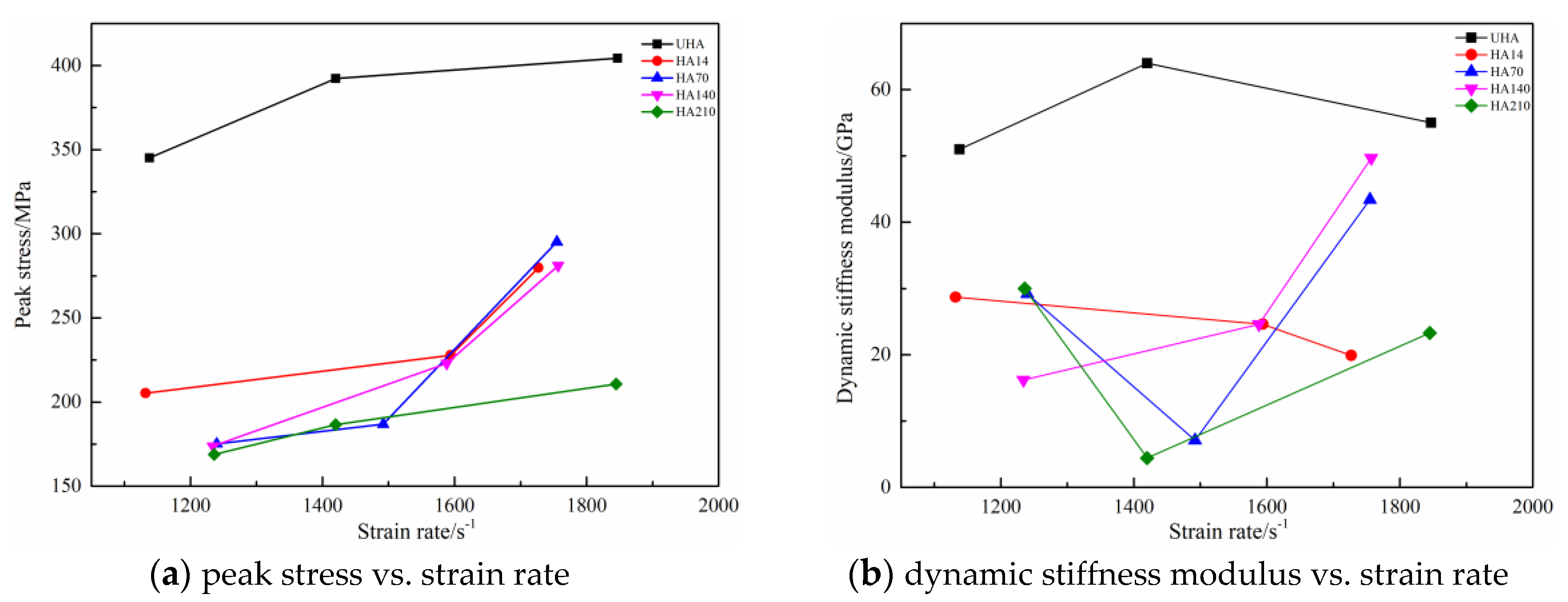
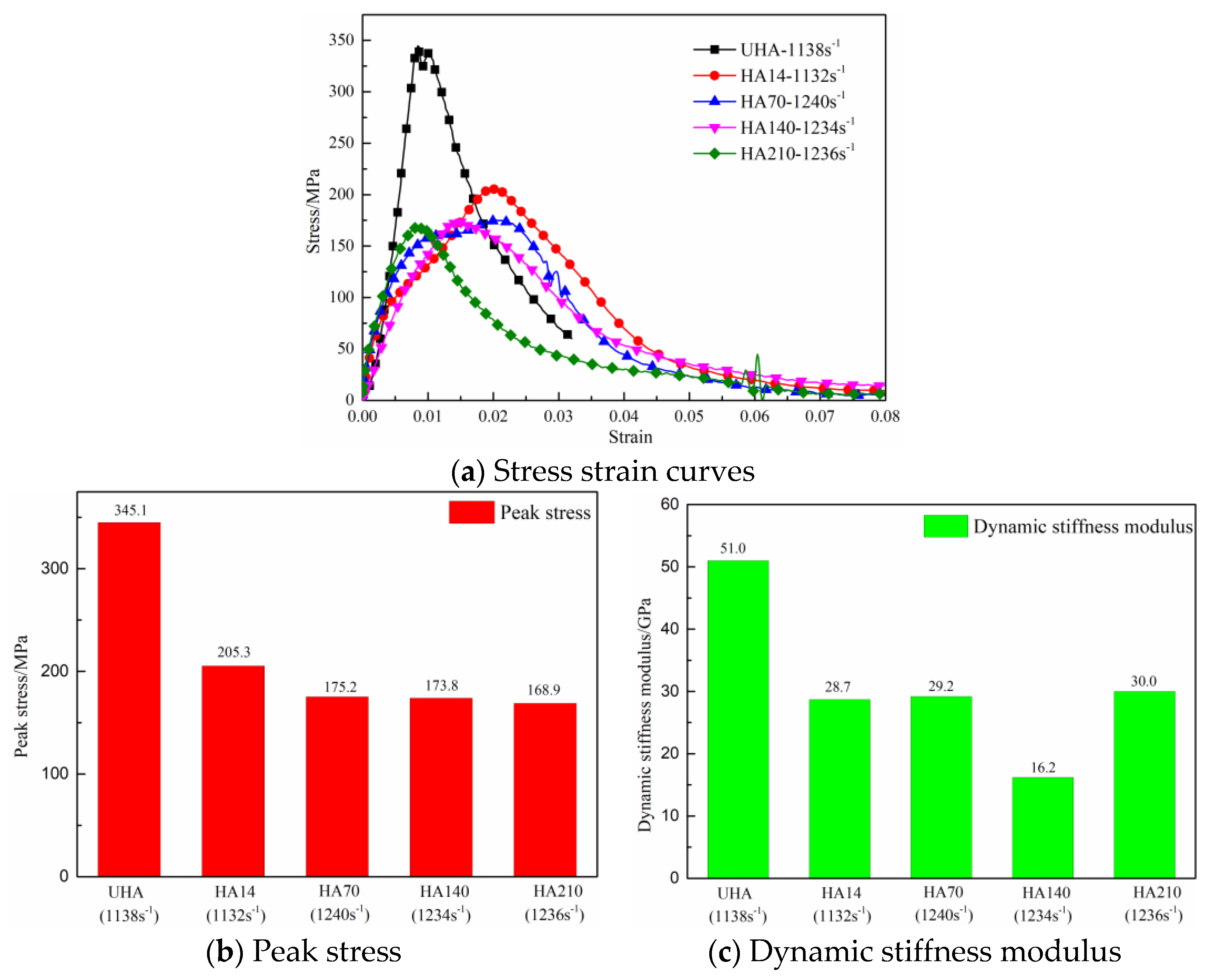
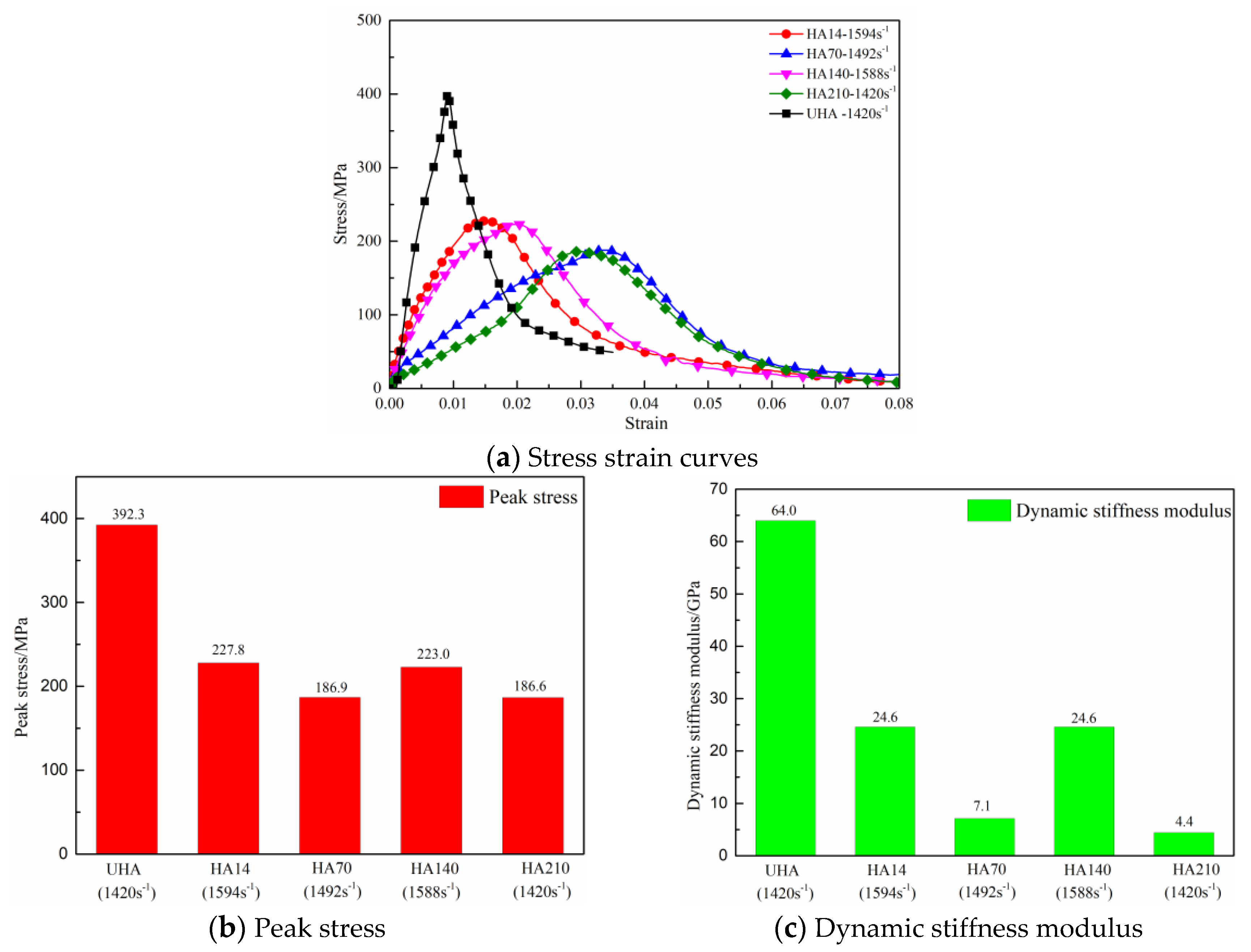
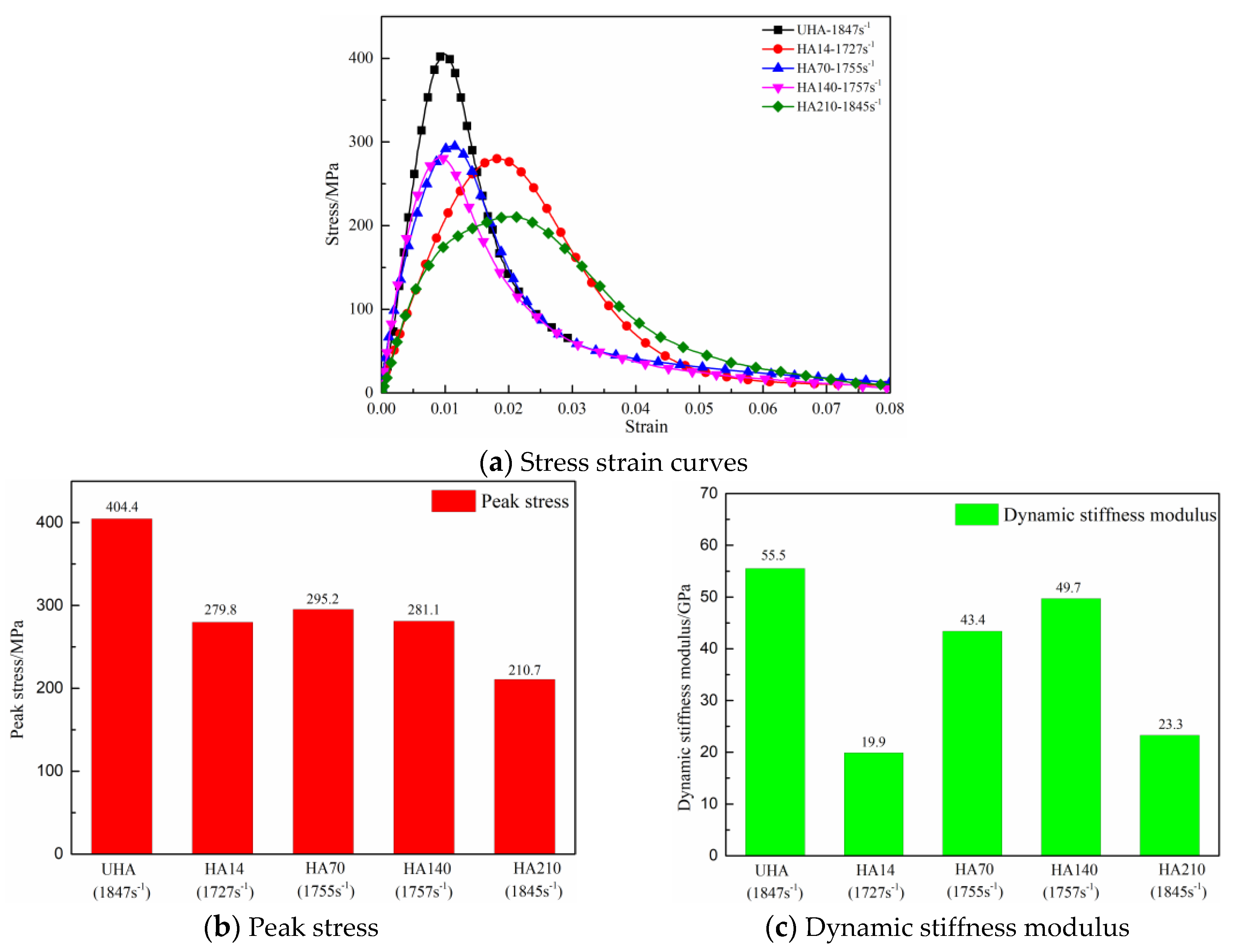
| Hygrothermal Aging Days | Average Weight W (g) | Standard Deviation | Water Content (%) |
|---|---|---|---|
| 0 | 15.6710 | 0.0320 | 0 |
| 14 | 15.7069 | 0.0323 | 0.2288 |
| 70 | 15.7267 | 0.0348 | 0.3550 |
| 140 | 15.7564 | 0.0344 | 0.5448 |
| 210 | 15.7799 | 0.0343 | 0.6944 |
© 2020 by the authors. Licensee MDPI, Basel, Switzerland. This article is an open access article distributed under the terms and conditions of the Creative Commons Attribution (CC BY) license (http://creativecommons.org/licenses/by/4.0/).
Share and Cite
Xu, K.; Chen, W.; Liu, L.; Luo, G.; Zhao, Z. Longitudinal Compressive Property of Three-Dimensional Four-Step Braided Composites after Cyclic Hygrothermal Aging under High Strain Rates. Appl. Sci. 2020, 10, 2061. https://doi.org/10.3390/app10062061
Xu K, Chen W, Liu L, Luo G, Zhao Z. Longitudinal Compressive Property of Three-Dimensional Four-Step Braided Composites after Cyclic Hygrothermal Aging under High Strain Rates. Applied Sciences. 2020; 10(6):2061. https://doi.org/10.3390/app10062061
Chicago/Turabian StyleXu, Kailong, Wei Chen, Lulu Liu, Gang Luo, and Zhenhua Zhao. 2020. "Longitudinal Compressive Property of Three-Dimensional Four-Step Braided Composites after Cyclic Hygrothermal Aging under High Strain Rates" Applied Sciences 10, no. 6: 2061. https://doi.org/10.3390/app10062061
APA StyleXu, K., Chen, W., Liu, L., Luo, G., & Zhao, Z. (2020). Longitudinal Compressive Property of Three-Dimensional Four-Step Braided Composites after Cyclic Hygrothermal Aging under High Strain Rates. Applied Sciences, 10(6), 2061. https://doi.org/10.3390/app10062061





